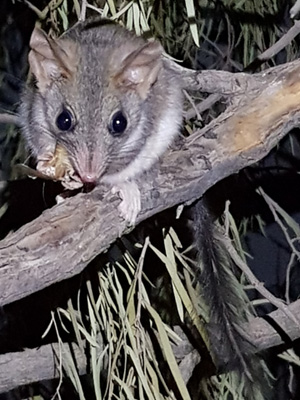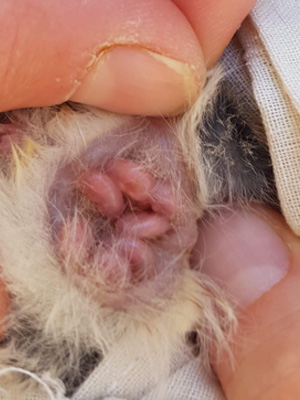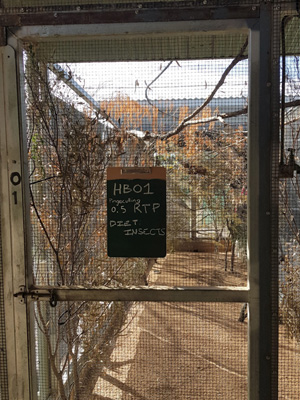Red-tailed Phascogale Breeding Boom!
The mammal keepers at the Desert Park are busy preparing for a surge in their Red-tailed Phascogale group as their breeding season is in full swing. The keepers can barely contain their excitement as this years’ breeding season has a different agenda in comparison to previous years. There is more to these mammals than a name that is difficult to say. Red-tailed Phascogales (pronounced “fas-koh-gale”) are a small carnivorous marsupial (dasyurids) about three times the size of a house mouse. They are sexually dimorphic with the males being the larger of the sexes. Being opportunistic feeders their diet is made up of a variety of insects and other invertebrates, small mammals and birds. They are predominantly arboreal, capable of leaping up to 2m between trees, taking refuge in tree hollows or logs during the day to rest. Before the arrival of Europeans their range extended through much of arid and semi-arid Australia including Central Australia however they are now restricted to remnant pockets of bushland in the wheatbelt region of south-west Western Australia and are classified as near threatened by the IUCN red list. The remaining populations have a strong association with Gastrolobium species, which are plants containing sodium monofluoroacetate (1080). Their presence seem to be benefitting native animals such as red-tailed phascogale’s as introduced animals, like sheep, cattle, cats and foxes for example, have no tolerance.
Red-tailed Phascogales have an interesting reproductive strategy which involves a huge investment into a single breeding season during winter with all males dying off within one month of mating. In the wild males live on average 11.5 months compared to females which may live up to 3 years. Only a small number of other species also exhibit this life history strategy termed semelparity. Alice Springs Desert Park continues to be involved in animal studies with collaborative institutions which have proven to be beneficial in establishing and developing management strategies required for long term captive sustainability and conservation purposes. In 2005 an honours student demonstrated that female red tailed phascogales will mate with multiple males throughout their single oestrous period over winter and are able to utilise sperm storage resulting in a litter with DNA belonging to different fathers. Although a female can give birth anywhere up to thirteen young, a maximum of eight will survive- one joey for each teat she has in her pouch.
The Red Tailed Phascogales have now been at the Alice Springs Desert Park since mid-May. We have 8 individuals residing in the Nocturnal House where they are on display with the Golden Bandicoots and the Greater Stick Nest Rats. With their boundless energy and inquisitive nature they are a fantastic and entertaining addition to the Nocturnal house and it is wonderful to see them running and jumping around the enclosures. A good tip to seeing them is, be patient and look for the typical shaking of leaves they create while jumping from branch to branch. Follow this movement and before long you should get a glimpse or, if you’re lucky, they will come closer to give you a good look at their vibrant red tails.
The exciting news is, we are also housing 16 females and 6 males in our holding/breeding area at the Desert Park. As with all dasyurids it can be difficult to successfully breed them and, in order to do this, since they arrived, we have been rotating the 6 males between the 4 groups of females twice a week and pouch checking every Thursday. Although a lot of work and very fiddly, happily, we have recently seen our first pouch young in two of our groups, with hopes the rest will follow closely behind. With the ability of each female to raise up to 8 pouch young each, we are hoping to have upwards of 100 young if all females are successful. Due to the considerable amount of planning, preparation and team work put into successfully breeding the Red-tailed Phascogales we will also have a fairly good idea of their parentage and age. This information will all be useful for the next stage of their lives…release in the Northern Territory.
Once the young Red-tailed Phascogales have become independent of their mothers at approximately three months, they will be sent to Newhaven Wildlife Sanctuary for release. This area is managed by the Australian Wildlife Conservancy. It is one of the largest protected wildlife areas in Austraila with an area of 261,501 hectare area in the Great Sandy Desert surrounded by a predator proof fence with feral cats and foxes being removed. In this area it is planned to reintroduce a number of endangered and extinct native species including Mala (Lagorchestes hirsutus), Greater Bilby (Macrotis lagotis), Burrowing Bettongs (Bettongia lesueur) and of course our Red Tailed Phascogales. The plan is to release them into the protected area. This area will give them an ability to establish territory largely without the threat of predation. Natural predators such as birds of prey and reptiles will still be present, however, these pressures will be minor. Once they have established, they will begin to spread. Given their size, it will be possible for them to leave the confines of the protected area, but hopefully with a persistent breeding colony in the protected area this can feed the persistence of colonies further afield. The introduction of these preliminary individuals we have bred at the Alice Springs Desert Park will also inform future attempts at Newhaven and potentially elsewhere. In order to do this we have also placed tracking collars on some of the individuals in the Nocturnal house where they can be closely monitored. So far it has gone well and we are well on track to successfully reintroducing this species into the Northern Territory where is has not been seen since the 1950’s.



